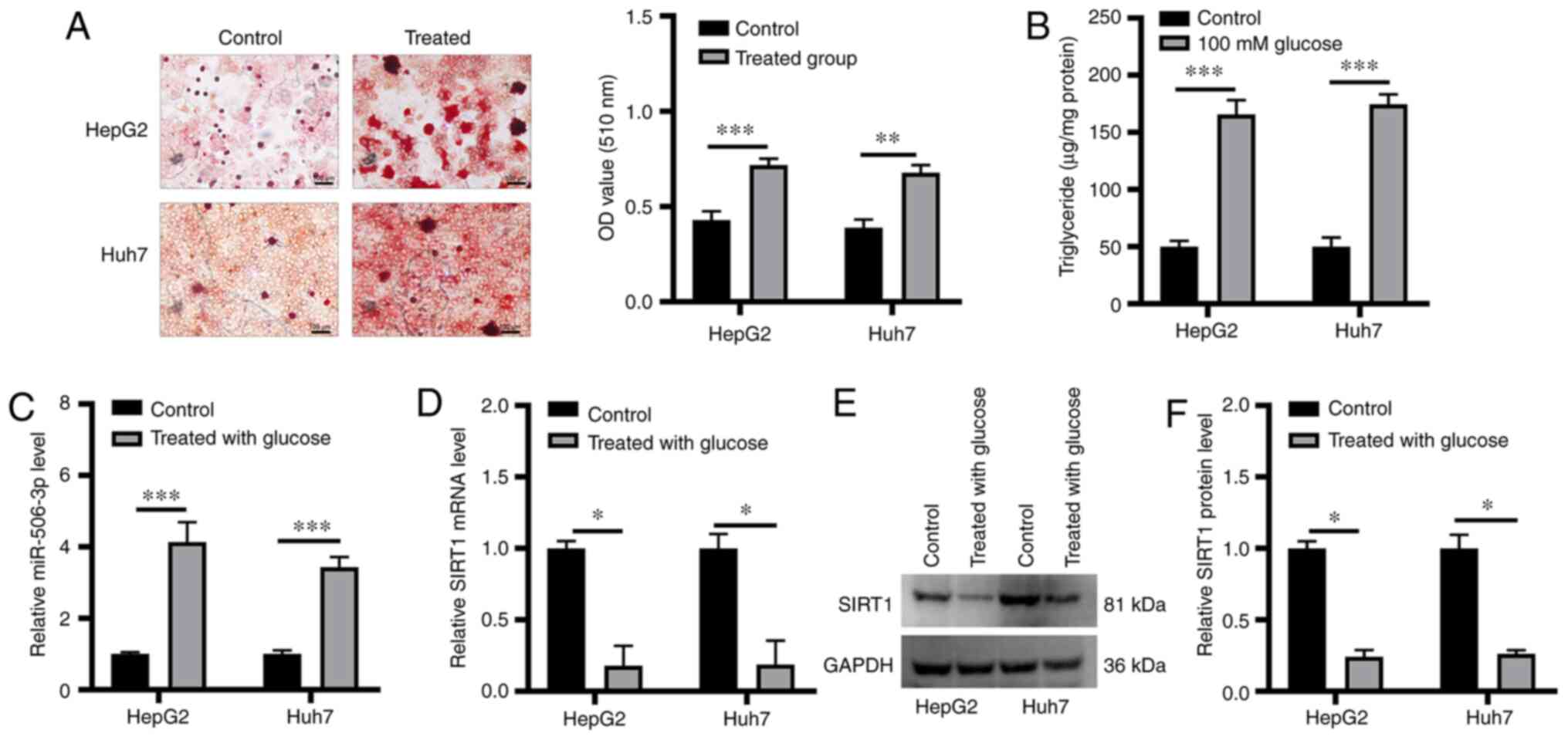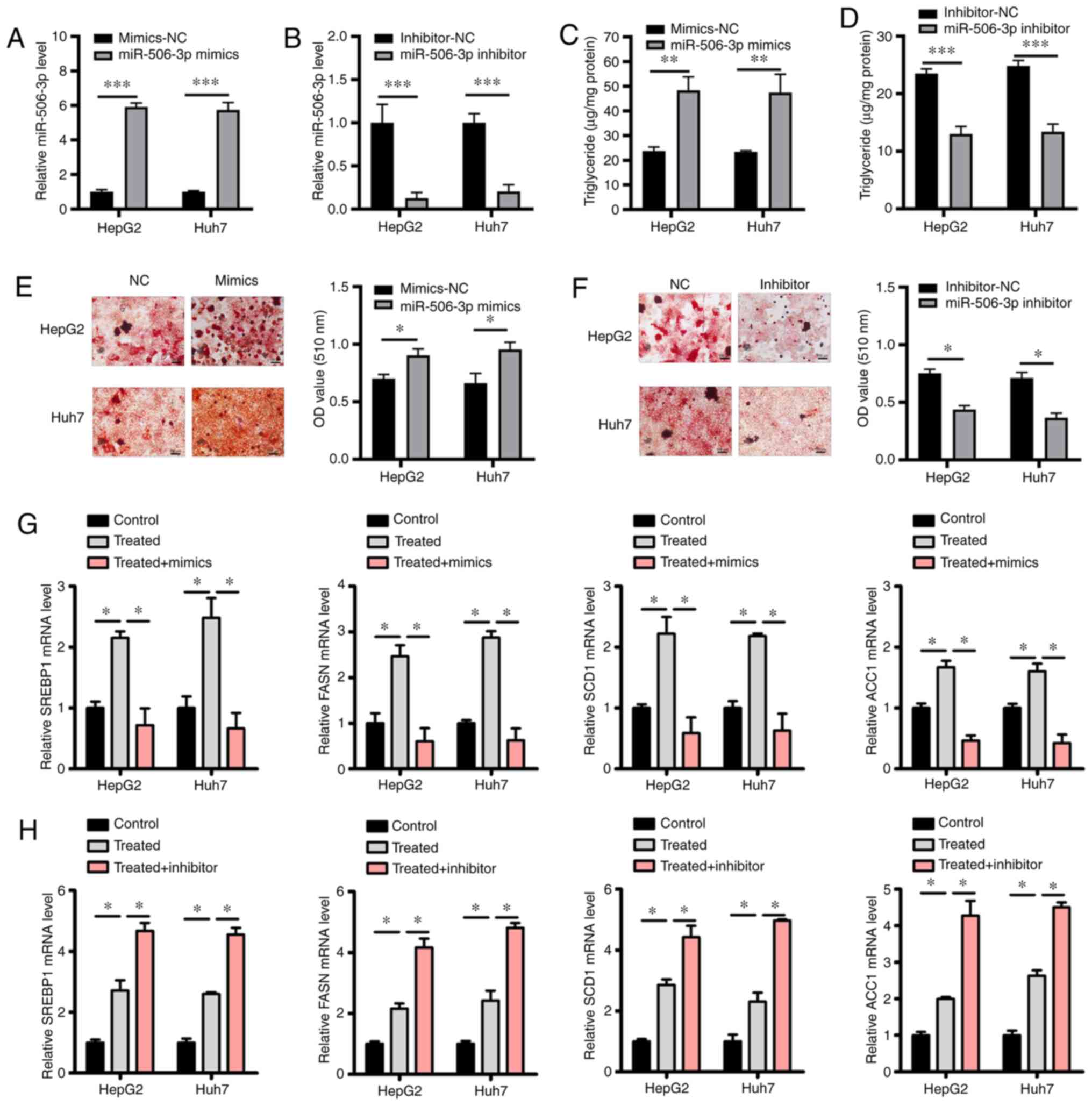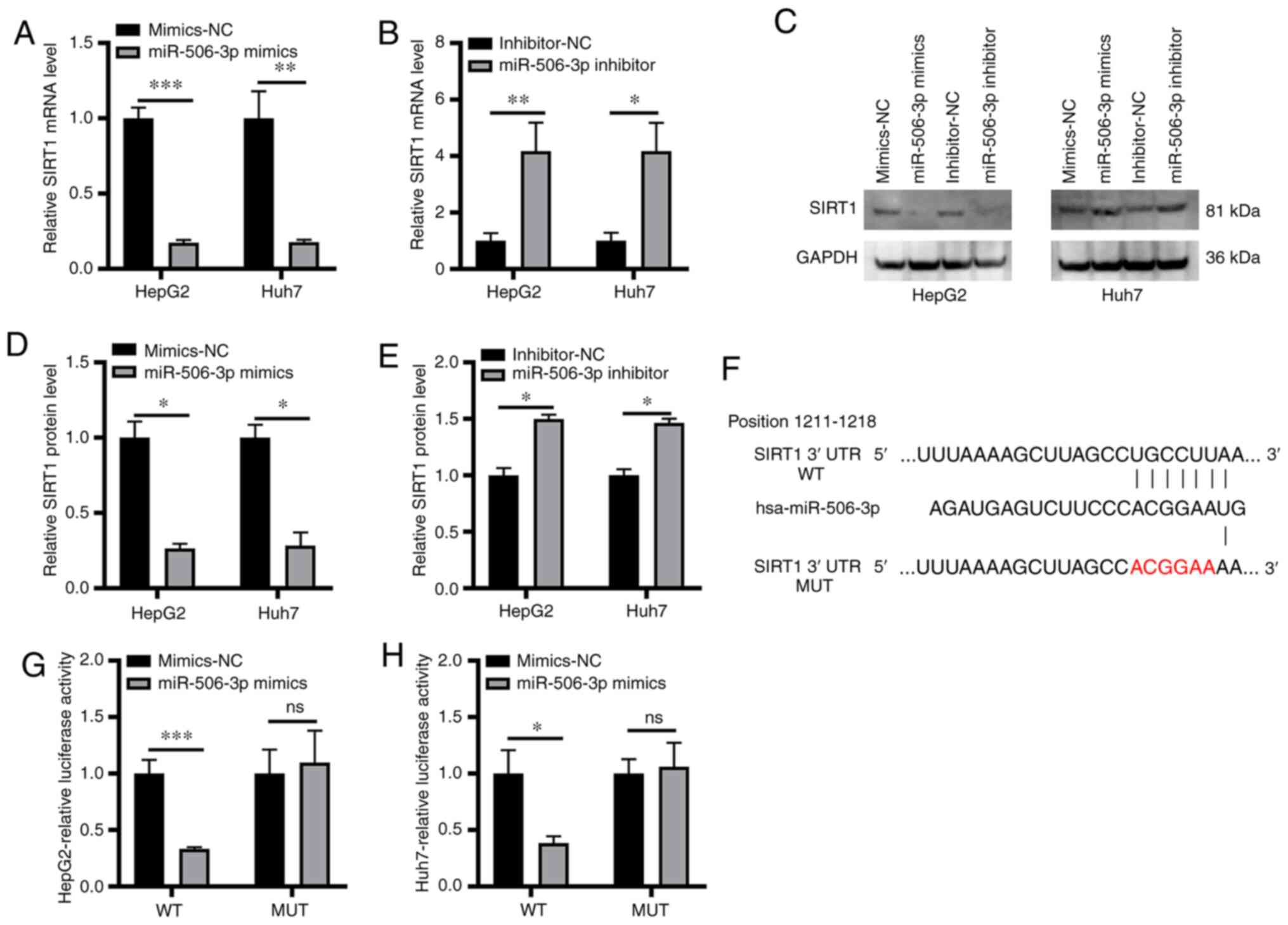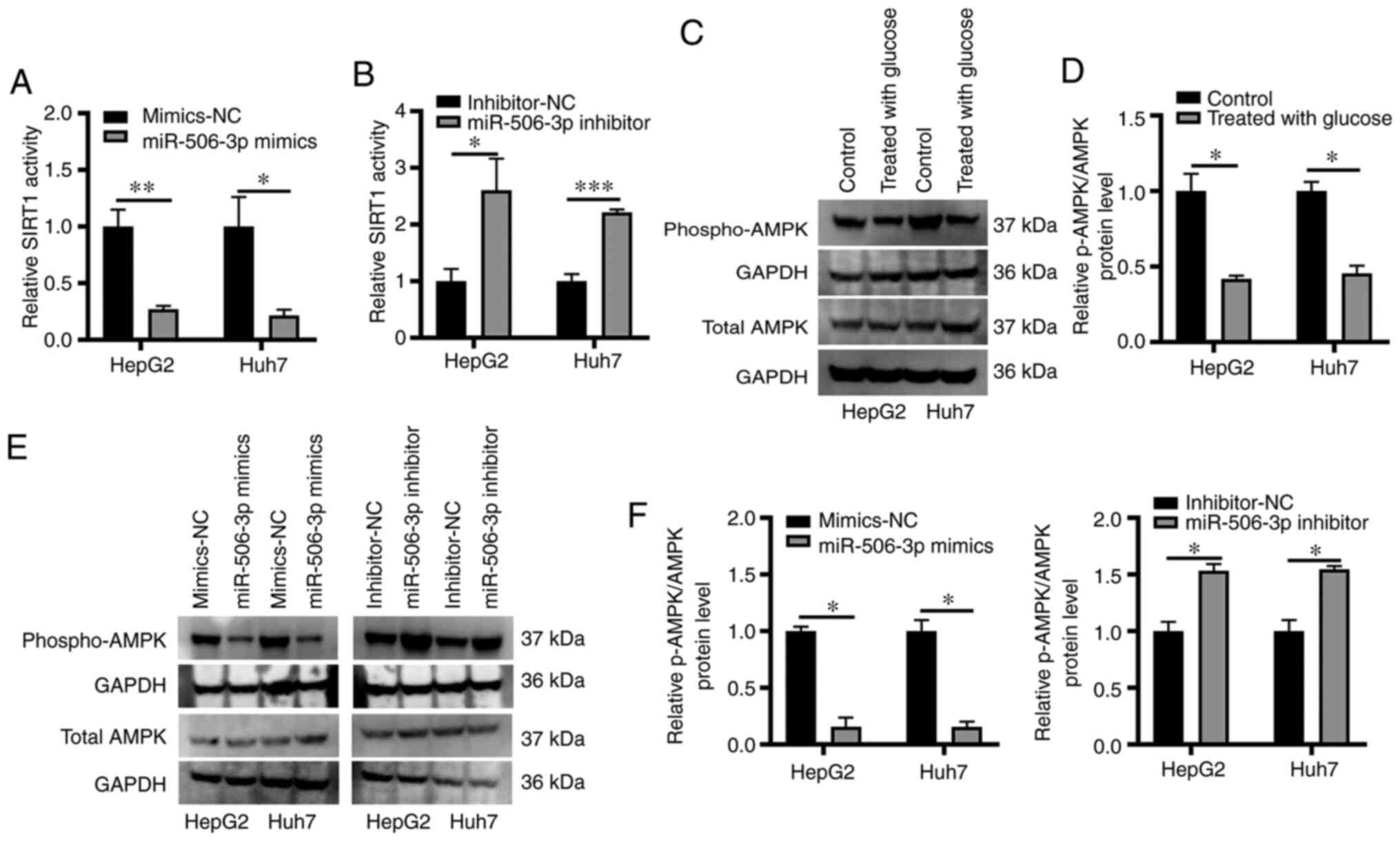|
1
|
Gui Y, Pan Q, Chen X, Xu S, Luo X and Chen
L: The association between obesity related adipokines and risk of
breast cancer: A meta-analysis. Oncotarget. 8:75389–75399.
2017.PubMed/NCBI View Article : Google Scholar
|
|
2
|
Benedict M and Zhang X: Non-alcoholic
fatty liver disease: An expanded review. World J Hepatol.
9:715–732. 2017.PubMed/NCBI View Article : Google Scholar
|
|
3
|
Nassir F and Ibdah JA: Sirtuins and
nonalcoholic fatty liver disease. World J Gastroenterol.
22:10084–10092. 2016.PubMed/NCBI View Article : Google Scholar
|
|
4
|
Tobita T, Guzman-Lepe J, Takeishi K, Nakao
T, Wang Y, Meng F, Deng CX, Collin de l'Hortet A and Soto-Gutierrez
A: SIRT1 disruption in human fetal hepatocytes leads to increased
accumulation of glucose and lipids. PLoS One.
11(e0149344)2016.PubMed/NCBI View Article : Google Scholar
|
|
5
|
Arab Sadeghabadi Z, Nourbakhsh M, Pasalar
P, Emamgholipour S, Golestani A, Larijani B and Razzaghy-Azar M:
Reduced gene expression of sirtuins and active AMPK levels in
children and adolescents with obesity and insulin resistance. Obes
Res Clin Pract. 12:167–173. 2018.PubMed/NCBI View Article : Google Scholar
|
|
6
|
Kitada M and Koya D: SIRT1 in type 2
diabetes: mechanisms and therapeutic potential. Diabetes Metab J.
37:315–325. 2013.PubMed/NCBI View Article : Google Scholar
|
|
7
|
Hardie DG: Minireview: the AMP-activated
protein kinase cascade: the key sensor of cellular energy status.
Endocrinology. 144:5179–5183. 2003.PubMed/NCBI View Article : Google Scholar
|
|
8
|
Hou X, Xu S, Maitland-Toolan KA, Sato K,
Jiang B, Ido Y, Lan F, Walsh K, Wierzbicki M, Verbeuren TJ, et al:
SIRT1 regulates hepatocyte lipid metabolism through activating
AMP-activated protein kinase. J Biol Chem. 283:20015–20026.
2008.PubMed/NCBI View Article : Google Scholar
|
|
9
|
Jinek M and Doudna JA: A three-dimensional
view of the molecular machinery of RNA interference. Nature.
457:405–412. 2009.PubMed/NCBI View Article : Google Scholar
|
|
10
|
Krol J, Loedige I and Filipowicz W: The
widespread regulation of microRNA biogenesis, function and decay.
Nat Rev Genet. 11:597–610. 2010.PubMed/NCBI View
Article : Google Scholar
|
|
11
|
Rottiers V and Näär AM: MicroRNAs in
metabolism and metabolic disorders. Nat Rev Mol Cell Biol.
13:239–250. 2012.PubMed/NCBI View
Article : Google Scholar
|
|
12
|
Ceccarelli S, Panera N, Gnani D and Nobili
V: Dual role of microRNAs in NAFLD. Int J Mol Sci. 14:8437–8455.
2013.PubMed/NCBI View Article : Google Scholar
|
|
13
|
Kerr TA, Korenblat KM and Davidson NO:
MicroRNAs and liver disease. Transl Res. 157:241–252.
2011.PubMed/NCBI View Article : Google Scholar
|
|
14
|
Lakner AM, Bonkovsky HL and Schrum LW:
microRNAs: Fad or future of liver disease. World J Gastroenterol.
17:2536–2542. 2011.PubMed/NCBI View Article : Google Scholar
|
|
15
|
Hu CY, You P, Zhang J, Zhang H and Jiang
N: MiR-506-3p acts as a novel tumor suppressor in prostate cancer
through targeting GALNT4. Eur Rev Med Pharmacol Sci. 23:5133–5138.
2019.PubMed/NCBI View Article : Google Scholar
|
|
16
|
Deng Q, Xie L and Li H: MiR-506 suppresses
cell proliferation and tumor growth by targeting Rho-associated
protein kinase 1 in hepatocellular carcinoma. Biochem Biophys Res
Commun. 467:921–927. 2015.PubMed/NCBI View Article : Google Scholar
|
|
17
|
Wang Z, Si M, Yang N, Zhang H, Fu Y, Yan
K, Zong Y, Zhu N and Wei Y: MicroRNA-506 suppresses invasiveness
and metastasis of human hepatocellular carcinoma cells by targeting
IL8. Am J Cancer Res. 8:1586–1594. 2018.PubMed/NCBI
|
|
18
|
Debes JD, Boonstra A and de Knegt RJ:
NAFLD-related hepatocellular carcinoma and the four horsemen of the
apocalypse. Hepatology. 71:774–776. 2020.PubMed/NCBI View Article : Google Scholar
|
|
19
|
Teras LR, DeSantis CE, Cerhan JR, Morton
LM, Jemal A and Flowers CR: 2016 US lymphoid malignancy statistics
by World Health Organization subtypes. CA Cancer J Clin.
66:443–459. 2016.PubMed/NCBI View Article : Google Scholar
|
|
20
|
Livak KJ and Schmittgen TD: Analysis of
relative gene expression data using real-time quantitative PCR and
the 2(-Delta Delta C(T)) Method. Methods. 25:402–408.
2001.PubMed/NCBI View Article : Google Scholar
|
|
21
|
Lin MJ, Dai W, Scott MJ, Li R, Zhang YQ,
Yang Y, Chen LZ and Huang XS: Metformin improves nonalcoholic fatty
liver disease in obese mice via down-regulation of apolipoprotein
A5 as part of the AMPK/LXRα signaling pathway. Oncotarget.
8:108802–108809. 2017.PubMed/NCBI View Article : Google Scholar
|
|
22
|
da Silva-Santi LG, Antunes MM,
Caparroz-Assef SM, Carbonera F, Masi LN, Curi R, Visentainer JV and
Bazotte RB: Liver fatty acid composition and inflammation in mice
fed with high-carbohydrate diet or high-fat diet. Nutrients.
8(8)2016.PubMed/NCBI View Article : Google Scholar
|
|
23
|
Santamarina AB, Oliveira JL, Silva FP,
Carnier J, Mennitti LV, Santana AA, de Souza GH, Ribeiro EB, Oller
do Nascimento CM, Lira FS, et al: Green tea extract rich in
epigallocatechin-3-gallate prevents fatty liver by AMPK activation
via LKB1 in mice fed a high-fat diet. PLoS One.
10(e0141227)2015.PubMed/NCBI View Article : Google Scholar
|
|
24
|
Cantó C, Gerhart-Hines Z, Feige JN,
Lagouge M, Noriega L, Milne JC, Elliott PJ, Puigserver P and Auwerx
J: AMPK regulates energy expenditure by modulating NAD+
metabolism and SIRT1 activity. Nature. 458:1056–1060.
2009.PubMed/NCBI View Article : Google Scholar
|
|
25
|
Lan F, Cacicedo JM, Ruderman N and Ido Y:
SIRT1 modulation of the acetylation status, cytosolic localization,
and activity of LKB1. Possible role in AMP-activated protein kinase
activation. J Biol Chem. 283:27628–27635. 2008.PubMed/NCBI View Article : Google Scholar
|
|
26
|
Kitade H, Chen G, Ni Y and Ota T:
Nonalcoholic fatty liver disease and insulin resistance: new
insights and potential new treatments. Nutrients.
9(9)2017.PubMed/NCBI View Article : Google Scholar
|
|
27
|
Cao Y, Jiang X, Ma H, Wang Y, Xue P and
Liu Y: SIRT1 and insulin resistance. J Diabetes Complications.
30:178–183. 2016.PubMed/NCBI View Article : Google Scholar
|
|
28
|
Purushotham A, Schug TT, Xu Q, Surapureddi
S, Guo X and Li X: Hepatocyte-specific deletion of SIRT1 alters
fatty acid metabolism and results in hepatic steatosis and
inflammation. Cell Metab. 9:327–338. 2009.PubMed/NCBI View Article : Google Scholar
|
|
29
|
Yuan JH, Yang F, Wang F, Ma JZ, Guo YJ,
Tao QF, Liu F, Pan W, Wang TT, Zhou CC, et al: A long noncoding RNA
activated by TGF-β promotes the invasion-metastasis cascade in
hepatocellular carcinoma. Cancer Cell. 25:666–681. 2014.PubMed/NCBI View Article : Google Scholar
|
|
30
|
Bartel DP: MicroRNAs: Genomics,
biogenesis, mechanism, and function. Cell. 116:281–297.
2004.PubMed/NCBI View Article : Google Scholar
|
|
31
|
Castro RE, Ferreira DM, Afonso MB,
Borralho PM, Machado MV, Cortez-Pinto H and Rodrigues CM:
miR-34a/SIRT1/p53 is suppressed by ursodeoxycholic acid in the rat
liver and activated by disease severity in human non-alcoholic
fatty liver disease. J Hepatol. 58:119–125. 2013.PubMed/NCBI View Article : Google Scholar
|
|
32
|
Colak Y, Yesil A, Mutlu HH, Caklili OT,
Ulasoglu C, Senates E, Takir M, Kostek O, Yilmaz Y, Yilmaz Enc F,
et al: A potential treatment of non-alcoholic fatty liver disease
with SIRT1 activators. J Gastrointestin Liver Dis. 23:311–319.
2014.PubMed/NCBI View Article : Google Scholar
|
|
33
|
Wang LF, Wang XN, Huang CC, Hu L, Xiao YF,
Guan XH, Qian YS, Deng KY and Xin HB: Inhibition of NAMPT
aggravates high fat diet-induced hepatic steatosis in mice through
regulating Sirt1/AMPKα/SREBP1 signaling pathway. Lipids Health Dis.
16(82)2017.PubMed/NCBI View Article : Google Scholar
|
|
34
|
Sun L, Wang Y, Song Y, Cheng XR, Xia S,
Rahman MR, Shi Y and Le G: Resveratrol restores the circadian
rhythmic disorder of lipid metabolism induced by high-fat diet in
mice. Biochem Biophys Res Commun. 458:86–91. 2015.PubMed/NCBI View Article : Google Scholar
|
|
35
|
Ao R, Wang Y, Tong J and Wang BF: Altered
microRNA-9 Expression Level is Directly Correlated with
Pathogenesis of Nonalcoholic Fatty Liver Disease by Targeting
Onecut2 and SIRT1. Med Sci Monit. 22:3804–3819. 2016.PubMed/NCBI View Article : Google Scholar
|
|
36
|
Kim HJ, Joe Y, Yu JK, Chen Y, Jeong SO,
Mani N, Cho GJ, Pae HO, Ryter SW and Chung HT: Carbon monoxide
protects against hepatic ischemia/reperfusion injury by modulating
the miR-34a/SIRT1 pathway. Biochim Biophys Acta. 1852:1550–1559.
2015.PubMed/NCBI View Article : Google Scholar
|
|
37
|
Boudaba N, Marion A, Huet C, Pierre R,
Viollet B and Foretz M: AMPK re-activation suppresses hepatic
steatosis but its downregulation does not promote fatty liver
development. EBioMedicine. 28:194–209. 2018.PubMed/NCBI View Article : Google Scholar
|


















